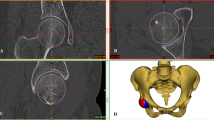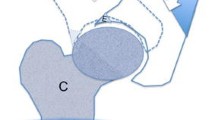Summary
The deformations and stresses acting on the acetabular rim have not been very precisely documented. The authors present a study based on an experimental simulation of hip loading with anatomic correlations. 122 dissections were performed in order to define the anatomic aspect of the roof (and especially of Byers's “area 17”) and the intermediate area between the anterior and posterior acetabular cornua. Ten fresh cadavers were tested on the lines of previous studies on monopodal or bipodal loading. An extensometric study was performed with special attention to the transverse acetabular ligament, supra-acetabular area and obturator foramen. The area 17 of Byers is a transitional zone and the mobility of the posterior cornu is 3 times that of the anterior cornu. Resection of the acetabular ligament modifies the displacement of the posterior cornu under loading but has no influence on deformation of the oburator foramen. The biomechanical behavior of the acetabular roof in the standing position is influenced by the conditions of monopodal or bipodal loading and by femoral rotation, but a tendency to extrusion was constantly noted.
Résumé
Les déformations et les contraintes en périphérie de l'acétabulum ont été peu étudiées. Les auteurs présentent un travail de corrélation entre les constatations anatomiques et la simulation expérimentale de mise en charge. 122 dissections ont été réalisées pour préciser l'aspect anatomique du toit et en particulier la “zone 17” de Byers, les régions intermédiaires avec les cornes antérieures et postérieures. 10 hanches de cadavres frais ont été étudiées selon les conditions classiques de mise en charge mono et bipodale. Une étude extensométrique a été pratiquée en tenant compte tout spécialement du ligament transverse, de la région supra-acétabulaire et du foramen obturé. La zone 17 de Byers est une zone transitionnelle et la mobilité de la corne postérieure est trois fois plus importante que celle de la corne antérieure. La section du ligament transverse de l'acétabulum modifie le déplacement de la corne postérieure au cours des mises en charge mais n'a pas d'influence significative sur la déformation du foramen obturé. Le comportement biomécanique du toit de l'acétabulum en position debout est influencé par les conditions d'appui mono ou bipodal, les rotations fémorales, mais une tendance constante à l'extrusion a été notée.
Similar content being viewed by others
References
Afoke NYP, Byers PD, Hutton WC (1980) The incongruous hip joint. J Bone Joint Surg [Br] 62-B n°4
Angevin S (1986) Contribution à l'étude de la répartition des contraintes dans l'articulation coxo-fémorale physiologique et prothésée. Thèse de Doctorat de l'Institut National Polytechnique (science des matériaux) Toulouse
Armstrong CG, Bahrani AS, Gardner DL (1979) In vitro measurement of articular cartilage deformations in the intact human hip joint under load. J Bone Joint Surg [Am] 61-A: 744–755
Besse JP (1982) Le cotyle, cet inconnu. Étude biodynamique. Propositions de prothèse cotyloïdienne adaptée à la biodynamique. Thèse de Doctorat en Médecine, Université Clermont I
Bombelli R, Santore RF, Poss R (1984) Mechanics of the normal and osteoarthritis hip. Clin Orthop 182: 69–78
Brinckmann P, Frobin W, Hierholzer (1981) Stress on the articular surface of the hip joint in healthy adults and persons with idiopathic osteoarthrosis of the hip joint. J Biomech 14: 149–156
Bullough PG, Goodfellow PG, Greenwald AS, O'Connor J (1968) Incongruent surfaces in the human hip joint. Nature 217: 1290
Byers PD, Contepomi CA, Farkas TA (1970) A post mortem study of the hip joint including the prevalence of the fealures of the right side. Ann Rheum Dis 29: 15–31
Caillot A (1982) Étude statique des déformations de la hanche normale et prothésée. Étude statique et dynamique d'un prototype de hanche prothétique déformable. Mémoire de Diplôme d'Ingénieur CNAM (mécanique) Paris
Carter DR, Vasu R, Harris WH (1982) Stress distributions in the acetabular region. II. Effects of cement thickness and metal backing of the total hip acetabular component. J Biomechanics 15: 165–170
Christel P, Derethe P, Sedel L (1980) Periacetabular pressure recording using a hip simulator. Acta Orthop Belg 46: 647–661
Day WH, Swanson SAV, Freeman MAR (1975) Contact pressures in the loaded human cadaver hip. J Bone Joint Surg [Br] 57-B: 302–313
Devars J, Revellin G, Sedel L, Watteau JP (1972) Mesure des contraintes osseuses au niveau du cotyle pendant la marche. Biomeca I, vol 1. Masson, Paris, Montpellier
Dietschi C, Schreiber A, Huggler AH, Jacob H (1975) Experimental investigation of deformation of the weight-bearing acetabulum. Troisième Symp de Biomécanique Osseuse [CIBO 24 Mai 1974] Acta Orthop Belg 41 [Suppl I]
Draenert K, Rudigier J (1978) Histomorphologie des Knochen Zemut Kontaktes. Chirurg 49: 276–285
Frain P (1981) Action mécanique de l'antéversion fémorale sur la hanche; degré de validité de la théorie de Pauwels. Rev Chir Orthop 67: 1–9
Frain P (1985) Évolution du vecteur gravitaire au cours de la marche. Corrections musculaires et cinématiques. Rev Chir Orthop 71: 537–547
Goel VK, Valiappan S, Svensson NL (1978) Stresses in the normal pelvis. Comput Biol Med 8: 91–104
Goodfellow JW, Mitsou A (1977) Joint surface incongruity and its maintenance. An experimental study. J Bone Joint Surg [Br] 59-B: 446–451
Greenwald AS, Haynes DW (1972) Weight-bearing areas in the human hip joint. J Bone Joint Surg [Br] 54-B: 157–163
Greenwald AS, O'Connor JJ (1971) The transmission of load through the human hip joint. J Biomechanics [GB] 4: 507–528
Jacob HAC, Huggler AH, Dietschi C, Schreiber A (1976) A mechanical function of subchondral bone as experimentally determined on the acetabulum of the human pelvis. J Biomech 9: 625–627
Jaramillo CV (1981) Étude biomécanique du cotyle et réflexions concernant les prothèses cotyloïdiennes. Thèse de Doctorat en Médecine, Université de Clermont I
Kummer B (1978) Anatomie fonctionnelle et biomécanique de la hanche. Acta Orthop Belg 44: 94–104
Laudet CG (1992) Evolution mécanique du cotyle et du bassin. Approche théorique et expérimentale. Thèse Université Pierre et Marie Curie, Paris VI
Lazennec JY (1987) Contribution à l'étude biomécanique du cotyle. Thèse de Doctorat d'Etat en Biologie Humaine, UER 56, Faculté de Médecine Pitié-Salpêtrière, Université Pierre et Marie Curie, Paris
Lazennec JY, Laudet CG, Feron JM, Guérin-Surville H (1988) Biomechanical study of the acetabulum by strain gauges on fresh cadavers. Transaction of the 44th Congress of the Scandinavian Orthopaedic Association, Arhus, June 8–11
Lazennec JY, Laudet CG, Roger B, Guérin-Surville H (1990) L'anatomie cartilagineuse et osseuse du cotyle humain. Étude préliminaire à l'analyse de la dynamique spécifique des cornes cotyloïdiennes. Bull Assoc Anatomistes 74: 21–27
Oonishi H, Isha H, Hasegawa T (1983) Mechanical analysis of the human pelvis and its application to the artificial hip joint by means of the three dimensional finite element method. J Biomech 16: 427–444
Pauwels F (1976) Biomechanics of the normal hip and diseased hip. Springer-Verlag, Berlin Heidelberg New York
Quesnel T, Gonon GP (1989) Étude des sollicitations et quantification des pressions subies par la hanche en appui monopodal dans le plan sagittal. Bull Assoc Anatomistes 73: 29–31
Rabischong P, Bonnel F, Oonhishi N, Asaada P, Micaleff JP (1977) Comportement biomécanique du bassin à l'état normal et avec prothèse totale de hanche. Rev Chir Orthop 63 [Suppl II]: 95–99
Rushfeldt PD, Mann RW, Harris WH (1979) Influence of cartilage geometry on the pressure distribution in the human hip joint. Science 204: 413–415
Rydell J (1966) Intravital measurements of forces acting on the hip joint. Studies on the anatomy and function of bone and joints. Evans G (ed) Springer-Verlag, Berlin, pp 53–68
Sedel L, Christel P, Derethe P (1979) Pressure transmission through the acetabulum using an animated cadaver pelvis. Trans Orthop Res Soc 4: 269
Taussat A (1981) Étude statique des déformations de la hanche. Simulation cinématique et dynamique de la marche en vue d'essais de matériel et matériaux prothétiques. Mémoire du Diplôome d'Ingérnieur CNAM, Clermont Ferrand
Teinturier P (1980) Présentation d'un simulateur des mouvements de hanche produisant le cycle de Rydell. 63è Congrès de l'Association des Anatomistes
Teinturier P, Terver S, Jaramillo CV, Besse JP (1984) La biomécanique du cotyle. SOFCOT, Réunion Annuelle. Rev Chir Orthop 70: 41–46
Vasu R, Carter DR, Harris WH (1982) Stress distribution in the acetabular regions before and after total hip joint replacement. J Biomech 15: 155–164
Weber G, Weber E (1838) Mécanique de la locomotion chez l'homme. Encyclopédie Anatomique, traduite par Jourdan
Author information
Authors and Affiliations
Rights and permissions
About this article
Cite this article
Lazennec, J., Laudet, C., Guérin-Surville, H. et al. Dynamic anatomy of the acetabulum: an experimental approach and surgical implications. Surg Radiol Anat 19, 23–30 (1997). https://doi.org/10.1007/BF01627730
Received:
Accepted:
Issue Date:
DOI: https://doi.org/10.1007/BF01627730




